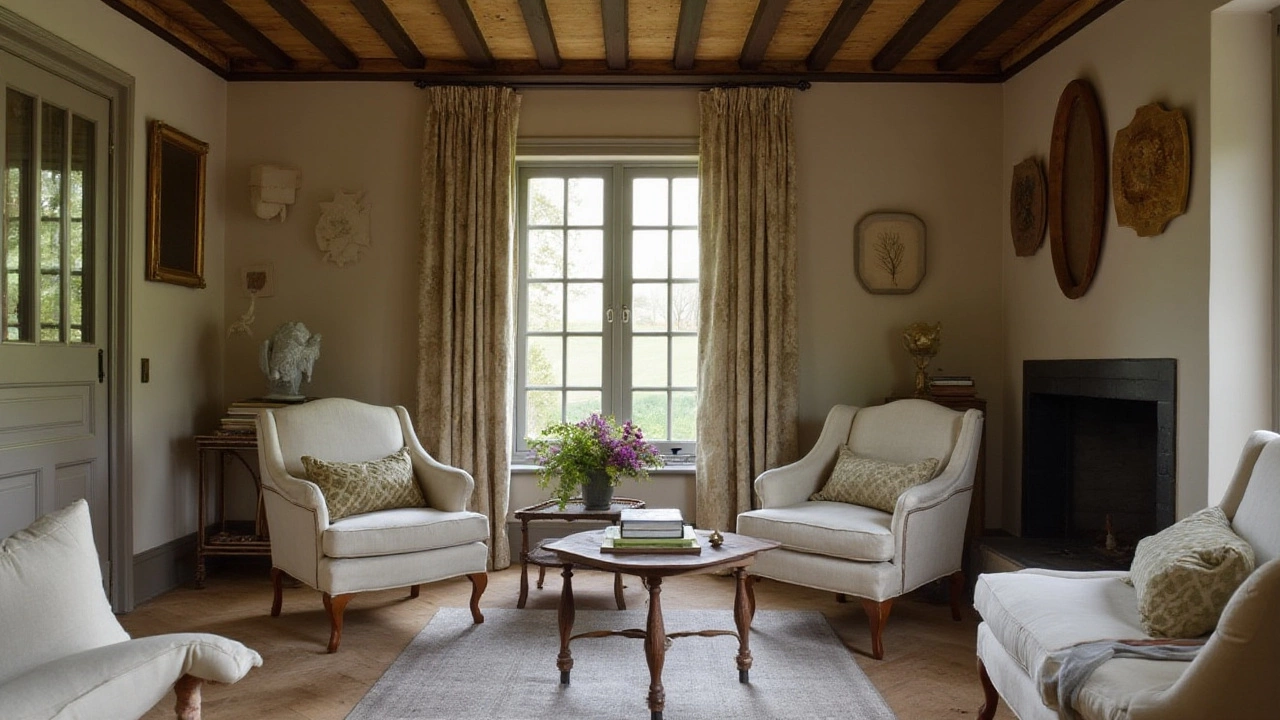In the world of interior design, creativity meets functionality, transforming spaces into works of art. But beyond the aesthetic appeal lies an important question: Can you make a lot of money in this field? The simple answer is yes, but like many professions, it depends on several factors.
Interior design is more than just arranging furniture or picking color palettes. It involves understanding a client's vision, mastering space planning, and often, a touch of psychology. How well you can merge these skills with business acumen can significantly influence your earnings.
Diving deeper, it's essential to consider your geographical location. Designers in bustling metropolitan areas often charge higher fees thanks to the cost of living and abundance of affluent clients willing to pay for premium service. Yet, success isn't tied only to your zip code. By building a solid reputation and leveraging a personal brand, designers can find lucrative opportunities on a global scale.
- Understanding Interior Design as a Profession
- Factors Influencing Earnings
- Pathways to Boosting Income
- Niche Specializations and Their Impact
- Tips for Financial Success in Interior Design
Understanding Interior Design as a Profession
Embarking on a career in interior design is like stepping into a world where imagination meets reality. It’s a profession that goes well beyond simply arranging furniture or selecting the right color schemes. At its core, interior design is about creating environments that are not only aesthetically pleasing but also functional and safe. Designers must grasp how spaces will be used, taking into account factors such as ergonomics and the psychology of color, not simply style. This makes for a challenging but deeply rewarding career path for those who are both creative and meticulous.
Interior designers are found in various environments and sectors. Some work at design firms, handling commercial spaces like hotels and offices, where their work can have a significant impact on the mood and productivity of thousands. Others may focus on residential projects, tailoring designs to fit the lifestyle and preferences of homeowners. Every new project brings a fresh set of demands and learning opportunities, allowing designers to stretch their creative muscles and problem-solving skills. This diversity in project types adds to the excitement of the profession and ensures that no two days are alike.
Regulations and standards are another key aspect of the profession. Designers need to be well-versed with building codes, safety standards, and sustainable practices. This can involve everything from making sure that a new office design complies with fire safety regulations to choosing materials that are both eco-friendly and durable. Formal education in design, therefore, often includes courses in safety codes and environmental design, providing a foundation in these essential areas. Additionally, certifications from reputable organizations such as the National Council for Interior Design Qualification establish a designer's credibility and enhance their skillset.
Despite its broad scope, there are misconceptions about the profession. Some perceive it as a luxury that only the affluent can afford, but many designers work across various budgets, offering tailored services to meet diverse needs. Digital platforms and social media have democratised design, enabling young designers to showcase their work to a global audience, irrespective of their client's budget or location. This not only expands the client base but also encourages upcoming designers to innovate and think outside the box.
Speaking about the impact of the evolving digital landscape, expert designer Jane Doe stated,
"The rise of social media has transformed the way we interact with clients and promote our services. It allows for a broader reach and an interactive relationship with potential clients, which was unimaginable a decade ago."Today's successful designers often complement their creative skills with a strong digital presence, using platforms such as Instagram or Pinterest to build a brand and attract clients worldwide.
The Importance of Soft Skills
Soft skills play an indispensable role in this profession. Designers must communicate effectively with clients to understand and translate their visions into reality. This requires active listening, empathy, and negotiation skills. Balancing aesthetics and client demands while staying within budgets requires tact and diplomacy. Furthermore, design projects often involve collaboration with other professionals like architects, contractors, and artists, making teamwork and leadership key skills. Those who excel combine their artistic talents with strategic insights and interpersonal skills, driving successful projects and client satisfaction.In essence, a career in interior design is much more than an eye for detail and creativity. It's about crafting spaces that speak to individuality and utility with thoughtful elegance. For those genuinely passionate about making a difference in their environments, interior design offers a fulfilling career with unlimited possibilities to explore, innovate, and impact lives positively.
Factors Influencing Earnings
When it comes to earning potential in the interior design industry, several key factors play a pivotal role. One of the primary elements is undoubtedly experience. Like many careers, a seasoned designer can command higher fees due to a proven track record of successful projects and satisfied clients. Experience often brings a deeper understanding of various styles, materials, and architectural challenges, allowing designers to create spaces that are not only beautiful but also functional.
Another significant factor is location. Designers based in urban centers like New York, Los Angeles, or London typically have access to a wealthier client base, enabling them to charge more for their services. These clients often look for designers who can provide high-end, unique solutions to meet their sophisticated tastes. However, even in less cosmopolitan areas, interior designers can thrive by adapting their services to meet local demands, whether that’s focusing on smaller residential projects or specializing in new builds.
Specialization within the interior design field can also impact income levels. Focusing on a niche such as healthcare design, hospitality, or sustainable design can set a designer apart from the crowd. Specializing allows clients to see them as experts in a particular area, which can lead to higher demands and, consequently, higher fees. According to the U.S. Bureau of Labor Statistics, niche interior design fields often see growth in both demand and financial compensation, making it a wise choice for those aiming to maximize their earnings.
"Success in interior design isn’t just about creation but consultation and connection," noted Maria Kilgore, renowned designer and author. "Understanding your client and strategically positioning yourself in the market often determines financial success."
Another considerable influence is the designer’s personal brand and marketing prowess. Potential clients often make decisions based on a designer’s reputation and portfolio, so investing time in building a strong online presence, participating in design shows, and networking with potential clients can significantly affect earning potential. Platforms like Instagram and Pinterest have become visual resumes, compelling designers to curate portfolios that highlight their versatility and vision, directly impacting clients’ willingness to pay premium prices.
Education and credentials may also contribute to a designer’s financial landscape. Holding a degree in interior design or architecture, obtaining certifications, and even continuous education through workshops or seminars can increase a designer’s credibility and justify higher rates. As the industry evolves, staying abreast of the latest trends and technologies, like 3D modeling software and sustainable materials, ensures a designer remains competitive.

Pathways to Boosting Income
Embarking on a journey to enhance your earnings as an interior designer can be both an exciting and daunting prospect. Let's explore some effective strategies you can employ to unlock the financial potential of your creative talents. First and foremost, consider diversifying your skills. While your core ability might be designing exquisite spaces, a smart designer knows the value of mastering additional competencies like project management, architectural software, and even basic carpentry. Expanding your skill set not only makes you more versatile but also allows you to offer a more comprehensive service to your clients, often at a premium. Clients love the idea of a one-stop-shop where they can find all the answers they need.
Networking also plays a significant role in elevating your income in the design world. Building relationships with contractors, architects, furniture suppliers, and even event planners can lead to numerous referral opportunities. Regularly attending industry events, forums, and workshops helps you connect with the right people who can help scale your business. There’s an old saying in the industry: “It’s not just what you know, but who you know.” Pairing your creative skill with strategic acquaintances can lead to lucrative projects and collaborations. The stronger and wider your network, the more opportunities will come your way. As respected designer Nate Berkus once stated, "Your home should tell the story of who you are, and be a collection of what you love brought together under one roof." This philosophy can extend to your professional life too, where personal connections tell the story of your career.
Another avenue worth exploring is specialization. While being a generalist has its perks, focusing on a niche area can enhance your client base and lead to better financial outcomes. Whether it's sustainable design, luxury interiors, or smart homes, carving out a niche allows you to stand out in a saturated market. It establishes you as a thought leader in your chosen area, encouraging clients seeking that specific expertise to seek you out, often willing to pay higher rates for your specialized knowledge.
Lastly, leveraging technology and social media platforms to market your services can substantially boost your visibility and, by extension, your income. Establishing a strong online presence through engaging websites and social media channels enables you to showcase your portfolio to a broader audience. When showcasing your work online, consider including aspects of your process and other engaging content that potential clients can interact with. Platforms like Instagram and Pinterest are particularly useful for visual professionals like interior designers. A personal website acts as your digital business card, available to anyone with internet access. With the right strategy, these digital tools can serve as powerful channels for attracting new clients and generating additional revenue streams.
The path to increased earnings in interior design involves continuous learning and adapting to new trends. By positioning yourself strategically through diversifying skills, networking, specialization, and making use of digital platforms, you can elevate your brand and unlock greater financial success. A dynamic and proactive approach can turn your passion for design into a profitable venture that not only supports your finances but also feeds your creative spirit.
Niche Specializations and Their Impact
Interior design is a vast and varied field, offering designers the opportunity to carve out their niche and make a name, and potentially a lot of money, based on unique specialties. A niche specialization can mean anything from focusing on eco-friendly designs to luxury spaces or even historical restorations. Each specialty comes with its own set of challenges and rewards, impacting a designer's earnings in different ways. For instance, designers who specialize in eco-friendly designs need to stay updated with the latest sustainable materials and technology, often charging a premium for their expertise in crafting spaces that reduce carbon footprints.
A growing trend within the industry is the focus on wellness design, which encompasses creating environments that promote health and well-being. This could include the use of natural light, organic materials, or spaces designed to reduce stress and enhance mental clarity. According to the Global Wellness Institute, the wellness real estate market was valued at $134 billion in 2022, reflecting a significant demand for this specialization. Designers who position themselves well in this niche could see their interior design income rise substantially.
The commercial sector also offers specialized niches, such as hospitality design. Here, designers work on creating engaging and functional environments for guests in hotels, restaurants, and leisure venues. This specialization requires an understanding of brand identity and customer psychology, which can lead to lucrative contracts with well-known chains or boutique establishments looking for a unique edge. A quote from renowned designer Kelly Wearstler emphasizes this:
"Designing for hospitality is about storytelling and creating experiences, each project is a chance to transport people to another world."This storytelling ability is what can set a designer apart and increase their financial success.
Technology also plays a role, with smart home design becoming increasingly popular. Designers who are proficient in integrating technology into interiors, such as automated lighting, security systems, or climate control, will find they can charge a premium for these complex projects. A survey conducted in 2023 found that 62% of potential homebuyers are willing to pay more for homes equipped with smart technology, highlighting the growing market for such expertise in design career earnings.
Finally, designers may choose to specialize in kitchen or bathroom design, two areas that not only require an eye for detail but also a thorough understanding of materials, appliances, and ergonomics. These rooms are often the most expensive to renovate due to the technical knowledge required in plumbing and electrical systems. As such, the interior decorator salary for these niches can be significantly higher than those in more generalized practices. Ultimately, the right niche can provide a designer with a distinctive brand that attracts clients willing to pay for expertise, creativity, and the ability to transform their visions into reality.

Tips for Financial Success in Interior Design
Pursuing a thriving career in interior design requires more than just a flair for aesthetics; it involves understanding market dynamics, client relations, and personal branding. To truly achieve financial success, an aspiring designer must be innovative, adaptable, and commercially savvy. One effective strategy is to establish a clear niche or specialty within the industry. Whether it's luxury residential spaces, eco-friendly designs, or office interiors, honing in on a specific type can set you apart and allow you to command higher fees. Specializing can also simplify marketing efforts, as you'll know exactly how to target your ideal client base.
Maximizing your interior design income is also about leveraging multiple revenue streams. Consider diversifying your services to include consultations, workshops, and online courses. Teach budding designers the tricks of the trade or offer webinars on the latest design trends. This approach not only solidifies your reputation as a knowledgeable expert but also taps into passive income potential. Additionally, collaboration is key. Partner with architects, builders, and real estate agents who can refer you to potential clients. Building a network of trusted partners can significantly expand your client list, leading to more projects and, consequently, increased career earnings.
Investing in yourself through continuous education is another powerful tip. Stay updated with the current design trends and technology by attending workshops and courses. Engaging with professional associations such as ASID (American Society of Interior Designers) can provide valuable resources and connections. Consider earning certifications that can boost your credibility and appeal to a broader range of clients. With evolving tastes and technologies in design, keeping your skills sharp ensures you remain in demand and relevant in the industry.
Another important aspect is the power of a personal brand. How you present yourself in both online and offline spaces can greatly affect your profitability. Cultivate an impressive online portfolio showcasing a diverse range of projects. Don't shy away from using social media channels to display your work; visibility can lead to unexpected opportunities. Encourage your satisfied clients to share testimonials and reviews, as word-of-mouth recommendations remain a potent marketing tool. As designer Kelly Wearstler once said,
"Design is meant to be enjoyed, and good design brings order to chaos. Approach every project with passion and your clientele will naturally expand."
For those keen on statistics, the Interior Design Compensation Report notes that in 2023, the median salary for interior designers in the U.S. was around $59,000. Interestingly, those who offer full-service design or engage in high-end projects often report incomes exceeding six figures. By leveraging these tips and strategies, navigating the path to higher earnings can become a structured endeavor rather than a daunting task. Ultimately, the key lies in blending creativity with business intelligence.
 EN
EN
 HR
HR
 AR
AR

